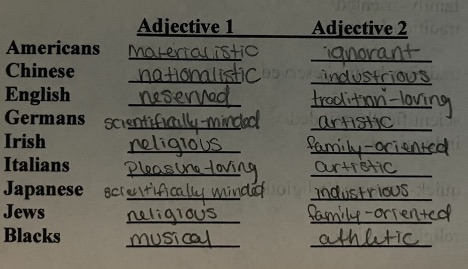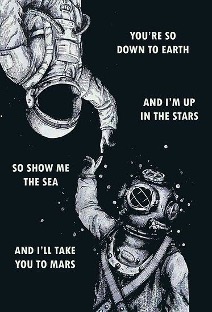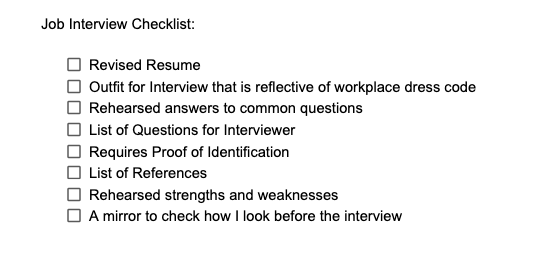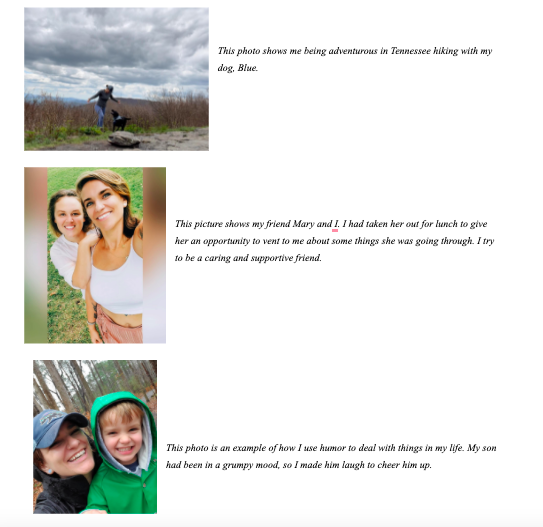Artifact 5
For Artifact 8, we were asked to list two adjectives from a list that we felt best described each group. This assignment was hard for me. I was very uncomfortable with labeling each group with the given adjectives. I feel like my overall attitude towards each group is shown in the adjectives I chose, and while I expect that to be true for others completing this assignment, it felt like I was doing the group a large injustice. I am at a place where I am actively working to rid myself of certain views and stereotypes that I associate with different groups. I look at the stereotypes I hold, when I recognize them, and try to assess where these beliefs came from and if I hold different groups to these stereotypes.
This assignment showed me how we may collectively have very similar stereotypes for certain groups, regardless of whether we mean to or not. It also highlighted for me how our differing experiences may cause our stereotypes to differ as well. My answers were different from the answers given in the 1933 and 1951 answers. However, those surveys showed similar answers, even given that they were taken at different periods of time. Even when the adjectives chosen for a certain group shift over time, the connotation behind the adjectives, whether positive or negative, may not change. I liked that this assignment helped me to gain perspective on the stereotypes we learn and often believe about other groups. Although humans use stereotyping to quickly give us information on people or scenarios in order to keep ourselves safe, many people often extend these stereotypes to affect the way they treat others. Being more cognizant of this fact can help teach people to be wary of the stereotypes we subscribe to, whether it is consciously or subconsciously.

Artifact 4
For the Module 3 Archive assignment, we considered the saying “Opposites attract” versus the concept that “similarity leads to attraction”. We considered what research there is to back each of these concepts while considering the opinions of others who we spoke to about it. While completing the assignment, it was not hard to get answers from people that agreed with either standpoint. I noticed that the way I worded the question and explanation seemed to directly affect the answers I was given. If I presented the question in a way that favored similarity, their response often followed suit. The same being true for the opposite standpoint.
This assignment taught me that we often look to define behaviors similarly. We can either say “opposites attract” as a rule or “similarity leads to attraction” as a rule and finds ways to support either argument. What we may fail to consider is the oversimplification of either viewpoint. We often find reasons to back up our beliefs, while leaving out reasons to support the opposing belief. However, we should be considering the truth in both statements and how each of these views can work for people at different times in different scenarios. For example, maybe I want someone who will watch scary movies with me, a similarity, while also valuing someone’s ability to broaden my palate with the different types of foods they like to eat, something opposite. I found that I consider each of these views in what I am attracted to, as do the people who I have spoken to about this subject.

Artifact 3
For the Module 5 Archive item, we used what we had learned about self-enhancement and other-enhancement to complete the assignment. We considered each perspective for given scenarios and responded with what we could do to aid in each of these things. What things could we do to help enhance ourselves and what could we do to better enhance other factors in the situation, things like how others perceive us.
I enjoyed this assignment. Making lists of how I can enhance different situations is a tool I use to help with my anxiety surrounding different situations. I often get stuck considering how I can make myself come off as well as possible, given the scenario. I often fail to consider the things that I can do to help others perceive the situation favorably. Things like making a positive comment to another person to try and help boost their mood so that they are more likely to see me favorably. This exercise helped me to consider how integrating that perspective into my anxiety management can help me get the outcome I am hoping for.

Artifact 2
Module 6 Archive had us consider how our personality traits show through in different scenarios. Do we change drastically given the situation and audience, or are most of our characteristics present during many given scenarios? I enjoyed this assignment because of the opportunity it gave me to assess how genuine and fair I am in given situations. I considered whether I show up with the same good energy for each scenario, or am I giving less effort in some scenarios? Am I a consistently adventurous person, or does this change depending on my audience? Questions like this helped me to reflect on my ability to be genuinely myself in different situations. I considered how each of my scenarios played out versus how they would have played out a decade ago. I had a much harder time being consistent with my actions when I was younger, I would often act the way I felt I should in a scenario rather than responding as my most authentic self.
While I acknowledge that responses may vary greatly at different points in a person’s journey or when they feel certain pressures based on their audience, I was happy to see that my actions are starting to become more predictable, and in turn, more accurate to the person I want to be and regularly portray.

Artifact 1
For the Module 11 Archive, we were to list 10 people we know and whether we felt they were happy or unhappy and whether they are selfish or unselfish. I enjoyed this assignment. It was reaffirming for me that it is a good thing to be a helpful person. I often wonder whether my efforts would be better spent helping myself rather than others due to lack of return in effort. However, our reading highlighted how studies prove that people who are prosocial and helpful are often happier. I also realized that the return I’m seeking may just be in the good feeling I get from doing the deed, not necessarily a returned good deed or effort. People can be helpful for underlying selfish reasons, but whether they are helping others for a positive feeling or not, it still supports prosocial behavior and happiness for the people involved. I may be someone who seeks out good deeds knowing I will feel good about myself after doing them, but that’s not a bad thing as long as I am truly being helpful.
